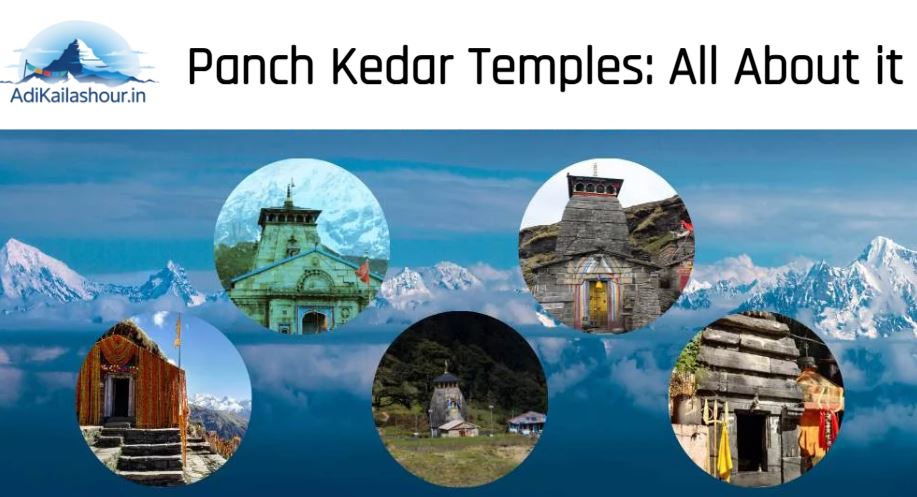Located in the majestic Garhwal Himalayas of Uttarakhand, India, the Panch Kedar temples represent five highly revered shrines dedicated to Lord Shiva, one of Hinduism’s principal deities. Known collectively as “Panch Kedar” (meaning “Five Kedars”), these temples are steeped in spiritual significance and rich mythology. Pilgrims travel from all over the world to worship Shiva in these ancient temples, which are connected by mythological tales linked to the Pandavas from the Indian epic Mahabharata. The Panch Kedar pilgrimage is not only a religious journey but also a trek through some of the most breathtaking Himalayan landscapes.
The Five Temples of Panch Kedar
- Kedarnath Temple: Located at an altitude of 3,583 meters (11,755 feet), Kedarnath is the most prominent and well-known among the Panch Kedar. It is situated near the Chorabari Glacier and is one of the twelve Jyotirlingas — the most sacred abodes of Lord Shiva. The temple is accessible via a trek of about 18 km from the base camp of Gaurikund.
- Tungnath Temple: Situated at an altitude of 3,680 meters (12,070 feet), Tungnath is the highest Shiva temple in the world. It is located near Chopta and is famous for its stunning views and serene surroundings. Tungnath is associated with the legend of the arms of Lord Shiva appearing at this site.
- Rudranath Temple: Perched at 3,559 meters (11,677 feet), Rudranath is known for its remote location surrounded by dense forests and alpine meadows. The temple is linked to the face of Lord Shiva and requires a trek of approximately 17 km from the nearest motorable point.
- Madhyamaheshwar Temple: Also referred to as Madmaheshwar, this temple is at an altitude of 3,490 meters (11,450 feet) and is famed for its peaceful ambiance amidst a picturesque valley. It symbolizes the navel and stomach of Lord Shiva according to legend.
- Kalpeshwar Temple: The lowest in altitude among the Panch Kedar at roughly 2,200 meters (7,200 feet), Kalpeshwar is unique because it remains open year-round, unlike the other four temples that close during winter months due to heavy snowfall. It is associated with the hair of Lord Shiva.
Mythological Origins of Panch Kedar
According to Hindu mythology, following the Kurukshetra war described in the Mahabharata, the Pandavas sought forgiveness from Lord Shiva for their sins of fratricide and Brahminicide. Shiva, displeased with the war’s violence, avoided them by taking the form of a bull (Nandi) and hiding in the Garhwal Himalayas near Guptakashi. Bhima, the second Pandava brother, recognized Shiva disguised as a bull and tried to catch him. However, Shiva vanished, reappearing in five parts throughout the region. Each part corresponds to one of the Panch Kedar temples: the bull’s hump at Kedarnath, arms at Tungnath, face at Rudranath, navel and stomach at Madhyamaheshwar, and hair at Kalpeshwar.
This divine scattering led the Pandavas to build temples at each location, providing devotees with the Panch Kedar pilgrimage route that remains popular to this day.
The Panch Kedar Pilgrimage
The Panch Kedar pilgrimage is traditionally completed in a specific order starting with Kedarnath, followed by Madhyamaheshwar, Tungnath, Rudranath, and finally Kalpeshwar. This circuit involves trekking across rugged mountain trails, passing through deep forests, glacial valleys, and remote villages. The entire pilgrimage spans over 170 kilometers and generally takes around 15 days to complete.
At the end of the Panch Kedar journey, it is customary to visit the Badrinath Temple, dedicated to Lord Vishnu, to seek his blessings and complete the spiritual experience.
Architecture and Cultural Importance
The Panch Kedar temples reflect the traditional North Indian Himalayan temple style with stone and wood carvings, steep pitched roofs, and intricate architecture that harmonizes with the natural surroundings. These temples serve as centers for festivals, religious ceremonies, and cultural gatherings, sustaining the spiritual heritage of the Garhwal region.
The priests serving these temples come from diverse sects including Jangamas, Dasnami Gosains, and local Brahmins, each contributing to the ritualistic and cultural practices unique to each temple.
Modern Challenges and Preservation
Many Panch Kedar temples, especially Kedarnath, have faced natural disasters such as floods and landslides, particularly the devastating 2013 Uttarakhand floods. Restoration efforts have focused on preserving the temples’ heritage while ensuring pilgrim safety through infrastructure improvements.
Conclusion
The Panch Kedar temples stand as a testament to deep spiritual traditions, legendary tales, and architectural beauty nestled within the Himalayas. A pilgrimage or trek to these five Shiva shrines is a profound journey combining devotion, adventure, and cultural immersion—an essential experience for seekers of spiritual and natural grandeur in Uttarakhand.

